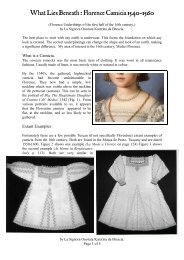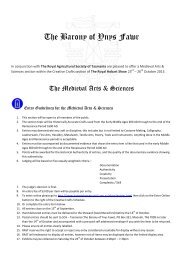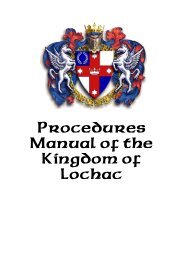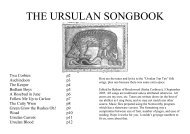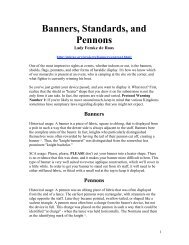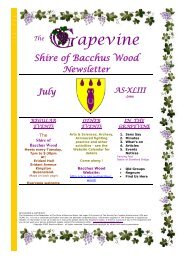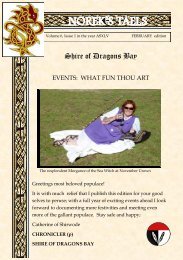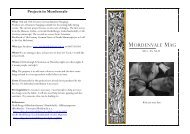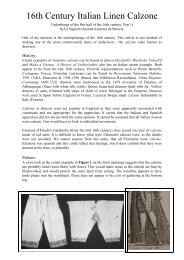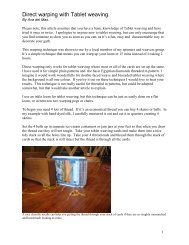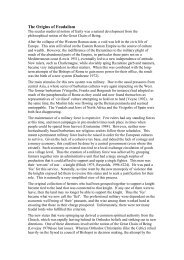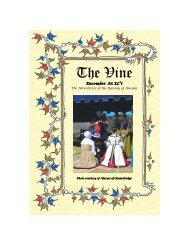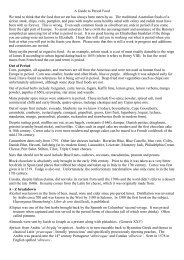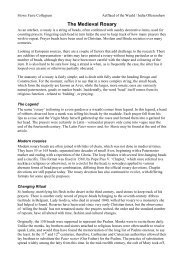Create successful ePaper yourself
Turn your PDF publications into a flip-book with our unique Google optimized e-Paper software.
<strong>Knitted</strong> Hats<br />
<strong>of</strong> <strong>the</strong> 15 th & 16 th Centuries<br />
A ‘Knitting Madonna’ circa 1390<br />
Submitted by: Cecilia Rosa de Sancta Maria<br />
A&S Category: Item(s) <strong>of</strong> warmth<br />
Event: September Baronial <strong>of</strong> St. Florian-de-la-Riviere,<br />
Date: September 3 rd , 2005
Table <strong>of</strong> Contents<br />
Introduction/Summary <strong>of</strong> <strong>the</strong> Project ..................................................................................3<br />
Knitting in Period....................................................................................................................3<br />
Redaction 1: A 15 th C. Acorn Hat for Middle/Lesser Nobility ...........................................5<br />
Acorn Hats in Period .................................................................5<br />
Materials.....................................................................................6<br />
Method/Pattern...........................................................................6<br />
Results/Comments......................................................................8<br />
Redaction 2: A 16 th C. Monmouth Cap for a Lower Working-Class, English Woman ..9<br />
Brief History <strong>of</strong> <strong>the</strong> Monmouth Cap in <strong>the</strong> SCA Period.........9<br />
Materials................................................................................11<br />
Method/Pattern.....................................................................12<br />
Results/Comments................................................................14<br />
Bibliography & Resources ...................................................................................................15<br />
Cecilia Rosa (Dani Lawson) 2<br />
Sept. Baronial 2005, A&S Entry
Introduction/Summary <strong>of</strong> <strong>the</strong> Project<br />
This project presents two knitted <strong>hats</strong>, as would have been worn throughout western<br />
Europe during <strong>the</strong> 15 th <strong>and</strong> 16 th centuries. The items presented are a tall acorn cap, suitable<br />
for a French (Burgundian)/Italian/or English gentleman <strong>of</strong> middle/lesser nobility <strong>and</strong> a<br />
‘Monmouth cap’ suitable for a lower working class female during <strong>the</strong> reign <strong>of</strong> Queen<br />
Elizabeth I.<br />
Both <strong>hats</strong> are knitted using yarn that was carded, plied <strong>and</strong> spun by h<strong>and</strong>, <strong>and</strong> using<br />
period knitting techniques (i.e. knitted in <strong>the</strong> round on 5, double-pointed needles, using<br />
stockinette stitch – fur<strong>the</strong>r details given in <strong>the</strong> following section). Although <strong>the</strong>se are not my<br />
first knitting projects, <strong>the</strong>y are my first attempts at adult <strong>hats</strong> or period headwear.<br />
Knitting in Period<br />
In <strong>the</strong> early 20 th century various items (socks, pouches, pillows) dating to <strong>the</strong> Roman<br />
period (4 th /5 th centuries CE) were found in Egypt <strong>and</strong> identified as being knitted items (Rutt,<br />
1987). This assumption was later contradicted by Burnham (1972), who re-analysed <strong>the</strong>m <strong>and</strong><br />
found that <strong>the</strong>y were in fact made through a method alternately referred to as single needle<br />
knitting or nalbinding. As a result, <strong>the</strong>re are relatively few knitted items dating to pre-1600 in<br />
museum collections.<br />
Although unable to specifically date <strong>the</strong> origin <strong>of</strong> knitting, we have strong evidence<br />
that it existed as early as <strong>the</strong> 14 th century, due to <strong>the</strong> existence <strong>of</strong> paintings (miniatures in<br />
particular) which depict Mary knitting, collectively called <strong>the</strong> ‘knitting madonnas’ (one such<br />
drawing is shown on <strong>the</strong> cover <strong>of</strong> this documentation).<br />
Tools<br />
The ‘knitting madonnas’ are shown using 3 or 4, double-pointed needles. Although<br />
<strong>the</strong>re are pictorial depictions <strong>and</strong> extant examples <strong>of</strong> knitting from <strong>the</strong> 14 th century <strong>and</strong> later,<br />
<strong>the</strong>re have been few pre-1600 examples <strong>of</strong> knitting tools found. It is conjectured that period<br />
Cecilia Rosa (Dani Lawson) 3<br />
Sept. Baronial 2005, A&S Entry
needles would have been made <strong>of</strong> bone, wood, or metal. The York Archaeological Trust for<br />
Excavation <strong>and</strong> Research describes <strong>the</strong> first pre-1600 knitting needles discovered in “The<br />
Archaeology <strong>of</strong> York: <strong>the</strong> Small Finds” (2002). This document describes two slender ‘rods’,<br />
tapering at <strong>the</strong> ends to 2.6mm <strong>and</strong> 1.9mm respectively. The rods are made <strong>of</strong> copper alloy,<br />
both measuring 180mm in length <strong>and</strong> dated to <strong>the</strong> late 14 th century. In general, knitting (in <strong>the</strong><br />
modern era) is done using needles <strong>of</strong> <strong>the</strong> same diameter, unless one needs to shape an item<br />
through changing <strong>the</strong> gauge <strong>of</strong> <strong>the</strong> material through <strong>the</strong> use <strong>of</strong> larger or smaller needles. The<br />
fact that <strong>the</strong> needles found were two different sizes has yet to be addressed by historians,<br />
although some suggest that in period, <strong>the</strong> use <strong>of</strong> two different sized needles, providing <strong>the</strong>y<br />
were close in diameter, would have been acceptable. The initial item would have differing<br />
tension in places due to <strong>the</strong> varied needles, however after repeated washing <strong>and</strong> wear, <strong>the</strong><br />
tension throughout <strong>the</strong> item would adjust.<br />
Period Knitting Technique<br />
Extant examples <strong>of</strong> period knitting show <strong>the</strong> exclusive use <strong>of</strong> ‘stockinette stitch’ (knitwise<br />
stitches) prior to <strong>the</strong> 1600’s (Rutt, 1987; Carlson, n.d.), giving knitted items (<strong>the</strong> outside<br />
that is) <strong>the</strong> characteristic ‘v’ design, <strong>and</strong> somewhat ‘braided’ appearance. There is pictorial<br />
<strong>and</strong> extant evidence <strong>of</strong> purl-wise stitches in use from <strong>the</strong> late 1500’s in stockings (ICEDragon<br />
research website). All pictorial <strong>and</strong> extant examples <strong>of</strong> knitting <strong>and</strong> needles suggest that<br />
period knitting was done ‘in <strong>the</strong> round’ using 3 – 5 needles. This style <strong>of</strong> knitting produces a<br />
tubular shape ideal for garments, pouches, <strong>hats</strong> <strong>and</strong> stockings, which corresponds to <strong>the</strong><br />
extant museum examples <strong>of</strong> pre-1600 knitting.<br />
It should be noted that no period knitting ‘patterns’ have been found. However, based<br />
upon <strong>the</strong> generalisations used in period cooking recipes, it is suggested that period knitters<br />
ei<strong>the</strong>r passed <strong>the</strong>ir patterns to one ano<strong>the</strong>r verbally, following <strong>the</strong> oral/practice tradition <strong>of</strong><br />
o<strong>the</strong>r craftspeople, or crafted items without a pattern, merely adding <strong>and</strong> subtracting stitches<br />
as needed to shape garments. It is this reason that I chose not to utilize <strong>the</strong> redactions<br />
Cecilia Rosa (Dani Lawson) 4<br />
Sept. Baronial 2005, A&S Entry
available from o<strong>the</strong>r historical re-enactors, instead creating my own pattern based upon <strong>the</strong><br />
wool I have spun, needles I have on h<strong>and</strong> <strong>and</strong> <strong>the</strong> hat shape/sizes that I needed.<br />
Materials<br />
Extant examples <strong>of</strong> period knitting are predominantly made <strong>of</strong> wool <strong>and</strong>/or silk.<br />
Period examples <strong>of</strong> <strong>hats</strong> are felted, making it impossible to determine <strong>the</strong> initial thickness/ply<br />
<strong>of</strong> <strong>the</strong> yarn used, however o<strong>the</strong>r items, such as scoggers (i.e. knitted sleeve protectors) <strong>and</strong><br />
stockings appear to have been made using 2 ply yarn, in a variety <strong>of</strong> thicknesses, including<br />
some very fine silk knitted at 20 or more stitches per inch (Flury-Lemburg, 1988).<br />
Redaction 1: A Tall Acorn Hat for Middle/Lesser Nobility<br />
Acorn Hats in Period<br />
Numerous paintings during <strong>the</strong> 15 th century depict men<br />
<strong>of</strong> various classes wearing what has come to be known as ‘acorn<br />
caps’: brimless, cloth or felted <strong>hats</strong> which could be ei<strong>the</strong>r close<br />
fitting (figure 2, man on <strong>the</strong> right) or tall domes (figure 2, man<br />
on left), <strong>of</strong>ten with a little ‘stalk’ or stem sticking out <strong>of</strong> <strong>the</strong> top<br />
(figure 3). Munro (n.d) notes that <strong>the</strong> height <strong>of</strong> one’s acorn hat<br />
appears to correspond to <strong>the</strong> social class <strong>of</strong> <strong>the</strong> wearer, as well as<br />
Figure 2: ‘Ordeal by Fire’ by Dieric<br />
Bouts <strong>the</strong> Elder, circa 1461<br />
<strong>the</strong> ‘current’ fashion. This being said, <strong>the</strong> basic style <strong>of</strong> <strong>the</strong> acorn<br />
hat stayed relatively unchanged throughout <strong>the</strong> mid-late 15 th<br />
century, as seen in <strong>the</strong> work <strong>of</strong> Rogier van der Weyden (c. 1430),<br />
Petrus Christus (c. 1449), Dieric Bouts (c. 1460’s-1470’s),<br />
Moulins (c. 1490).<br />
Some acorn <strong>hats</strong> appear to show seams at <strong>the</strong> topmost part<br />
<strong>of</strong> <strong>the</strong> hat, which contributes to <strong>the</strong> domed shape. If <strong>the</strong> hat is<br />
Figure 3: Self Portrait, Dieric Bouts<br />
<strong>the</strong> Elder, circa 1462<br />
made <strong>of</strong> fabric or merely felted/blocked wool, <strong>the</strong>n it is possible<br />
Cecilia Rosa (Dani Lawson) 5<br />
Sept. Baronial 2005, A&S Entry
that <strong>the</strong> pieces had graduated triangular tops, which were <strong>the</strong>n stitched toge<strong>the</strong>r. However, it<br />
is known by both extant examples <strong>of</strong> <strong>hats</strong> <strong>and</strong> household accounts that knitted <strong>hats</strong> were in<br />
use during this period, as seen in <strong>the</strong> following account:<br />
1463 – Pour deux chappeaulx noirs faiz a l’aiguill [pour le roi]<br />
trans. For two black knitted <strong>hats</strong> [for <strong>the</strong> king]<br />
(Gay, cited in Munro, n.d.)<br />
Ano<strong>the</strong>r extant example is <strong>the</strong> Gunnister cap, a tall (-ish) acorn cap dated to <strong>the</strong> late 16 th<br />
century. This cap is knitted at a reasonably tight gauge (8 stitches per inch) in stockinette<br />
stitch, with no visible seams (even at <strong>the</strong> crown) <strong>and</strong> with a turned hem (Henshall <strong>and</strong><br />
Maxwell, 1951-52). It is this extant example that inspired my first hat redaction. My<br />
redaction is designed to be suitable in both height <strong>and</strong> colour (Figure 2) for a gentleman <strong>of</strong><br />
lesser/middle/nobility or a merchant in good st<strong>and</strong>ing.<br />
Materials Used<br />
5 knitting needles – 4mm diameter 1 gallon <strong>of</strong> very hot water<br />
approximately 100 g. black, merino wool<br />
scrap yarn to mark <strong>the</strong> start <strong>of</strong> <strong>the</strong> round<br />
4 h<strong>and</strong>towels<br />
a sunny day<br />
Method/Pattern<br />
I began by carding <strong>the</strong> ends <strong>of</strong> <strong>the</strong> wool, which ‘fluffs’ <strong>the</strong>m up, making <strong>the</strong>m easier<br />
to spin. The yarn was spun using a modern replica <strong>of</strong> a Saxony spinning wheel (which was in<br />
use from <strong>the</strong> mid 1600’s on). In <strong>the</strong> modern replica (an Ashford ‘Traditional’), <strong>the</strong> wheel is<br />
situated closer to <strong>the</strong> flyer (<strong>the</strong> bobbin on which <strong>the</strong> spun wool is wound), <strong>and</strong> <strong>the</strong> angle is not<br />
as steep. After plying <strong>the</strong> wool, I washed it in warm water <strong>and</strong> hung it to dry, which serves to<br />
‘set’ <strong>the</strong> twist. The resulting yarn is roughly equivalent to 2 – 4 ply, baby weight, worsted<br />
yarn.<br />
1. Cast 120 stitches onto 4 needles, roughly 2 stitches per centimetre.<br />
Cecilia Rosa (Dani Lawson) 6<br />
Sept. Baronial 2005, A&S Entry
- this number was determined because <strong>the</strong> required diameter <strong>of</strong> <strong>the</strong> finished hat<br />
needed to be 52-56 centimetres, but needed to allow for shrinkage through <strong>the</strong><br />
felting/fulling process. Wool items tend to shrink more in length than in width,<br />
thus I made <strong>the</strong> final hat double <strong>the</strong> desired length, but only slightly larger<br />
than needed in width.<br />
2. Transfer <strong>the</strong> first stitch onto <strong>the</strong> needle holding <strong>the</strong> last stitch, begin by knitting <strong>the</strong>se<br />
two stitches toge<strong>the</strong>r. Place a stitch marker at this point.<br />
3. Knit regularly until <strong>the</strong> hat measures approximately 12-14 inches from <strong>the</strong> cast on<br />
row.<br />
4. Knit 5, k2tog; repeat to <strong>the</strong> end <strong>of</strong> <strong>the</strong> row.<br />
5. Knit <strong>the</strong> next 3 rows regularly.<br />
6. Knit 4, K2tog; repeat to <strong>the</strong> end <strong>of</strong> <strong>the</strong> row.<br />
7. Knit <strong>the</strong> next 2 rows regularly.<br />
8. Knit 3, K2tog; repeat to <strong>the</strong> end <strong>of</strong> <strong>the</strong> row.<br />
9. Knit <strong>the</strong> next 2 rows regularly.<br />
10. Knit 2, K2tog; repeat to <strong>the</strong> end <strong>of</strong> <strong>the</strong> row.<br />
11. Knit 1 row.<br />
12. K2tog; repeat for two rows.<br />
13. Continue this decrease until <strong>the</strong>re are no more stitches. Break yarn <strong>and</strong> pull <strong>the</strong> tail<br />
inside <strong>the</strong> hat, weaving into <strong>the</strong> stitches to lock it.<br />
14. Felt <strong>the</strong> hat: soak <strong>the</strong> hat momentarily in VERY hot water. Wring it out <strong>and</strong> pound it<br />
against a hard surface (I used <strong>the</strong> inside <strong>of</strong> <strong>the</strong> laundry sink), periodically flattening<br />
<strong>the</strong> hat (without stretching it) <strong>and</strong> rubbing your h<strong>and</strong>s up/down <strong>and</strong> side/side <strong>of</strong> both<br />
<strong>the</strong> inside <strong>and</strong> outside <strong>of</strong> <strong>the</strong> hat (opens <strong>and</strong> fluffs <strong>the</strong> wool fibers). Repeat this process<br />
until you can no longer see <strong>the</strong> individual knitting stitches <strong>and</strong> <strong>the</strong> hat resembles<br />
coarse felt.<br />
Cecilia Rosa (Dani Lawson) 7<br />
Sept. Baronial 2005, A&S Entry
15. Wring <strong>the</strong> hat as dry as you can (again, don’t stretch it). Ball up one towel loosely <strong>and</strong><br />
pack into <strong>the</strong> base <strong>of</strong> <strong>the</strong> hat, <strong>the</strong>n roll <strong>the</strong> o<strong>the</strong>r three towels into cylinders, using <strong>the</strong>m<br />
to prop <strong>the</strong> hat into a st<strong>and</strong>ing position.<br />
16. Sit <strong>the</strong> hat in a warm sunny place to dry.<br />
Results/Comments<br />
To date, this was <strong>the</strong> most difficult pattern I’ve tried<br />
because I was creating if <strong>of</strong>f <strong>the</strong> top <strong>of</strong> my head (a bad pun,<br />
I admit :). The hat took approximately 3 weekends to<br />
complete, although around <strong>the</strong> midway point I was getting<br />
concerned that it would be way too big. I had originally<br />
intended to leave <strong>the</strong> brim as a rolled brim (as stockinette<br />
stitch rolls in on itself naturally), but after fur<strong>the</strong>r research<br />
realized that rolled brims on this style <strong>of</strong> hat are completely inappropriate. However, through<br />
<strong>the</strong> fur<strong>the</strong>r research I discovered that this style <strong>of</strong> hat <strong>of</strong>ten had a doubled/hemmed brim. So<br />
prior to felting <strong>the</strong> hat, I used some <strong>of</strong> <strong>the</strong> leftover yarn <strong>and</strong> stitched <strong>the</strong> folded brim.<br />
I’ve never felted anything before <strong>and</strong> was concerned that I wasn’t ‘doing it right’,<br />
however I’m extremely pleased with <strong>the</strong> completed project – as is Lord Raphael, who now<br />
has a warm, yet period hat to wear at festival.<br />
Redaction 2: A Monmouth Cap for a Lower<br />
Working-Class, English Woman<br />
A Brief History <strong>of</strong> <strong>the</strong> Monmouth Cap<br />
The Monmouth cap is named for <strong>the</strong><br />
Welsh town <strong>of</strong> Monmouth, which lies on <strong>the</strong><br />
Wye river. The geographic position <strong>of</strong><br />
Monmouth, near a ready export medium <strong>and</strong> a<br />
Cecilia Rosa (Dani Lawson) 8<br />
Figure 4: Monmouth Cap, on display in at <strong>the</strong> Nelson Museum & Local<br />
Sept. Baronial 2005, A&S Entry<br />
History Centre, circa 16 th century.
thriving sheep industry nearby, aided in it’s positioning as a forerunner in <strong>the</strong> English knitting<br />
industry during <strong>the</strong> 15 th <strong>and</strong> 16 th centuries (Carlson, 2005).<br />
Monmouth as a town flourished during <strong>the</strong> 15 th <strong>and</strong> 16 th centuries due to <strong>the</strong> dem<strong>and</strong><br />
for, <strong>and</strong> export <strong>of</strong>, <strong>the</strong> Monmouth cap. This dem<strong>and</strong> was helped along by various statues from<br />
Henry VII (<strong>the</strong> Cappers Act <strong>of</strong> 1488) <strong>and</strong> Queen Elizabeth I (An Act for <strong>the</strong> Continuance <strong>of</strong><br />
<strong>the</strong> Making <strong>of</strong> Caps, 1571). The Cappers Act <strong>of</strong> 1488, forbade <strong>the</strong> wearing <strong>of</strong> foreign made<br />
caps, under <strong>the</strong> penalty <strong>of</strong> a fine, likewise, <strong>the</strong> 1571 statute by Elizabeth I decreed that:<br />
...all [males] above <strong>the</strong> age <strong>of</strong> six years except some <strong>of</strong> certain state<br />
<strong>and</strong> condition, shall wear upon <strong>the</strong> Sabbath <strong>and</strong> Holydays, one cap<br />
<strong>of</strong> wool knit, thicked <strong>and</strong> dressed in Engl<strong>and</strong>, upon <strong>the</strong> forefeiture<br />
<strong>of</strong> 3s 4d... .<br />
Women also fell under this statute as <strong>the</strong>y “...were constrained to wear white knit caps <strong>of</strong><br />
woolen yarn, unless <strong>the</strong>ir husb<strong>and</strong>s were <strong>of</strong> good value in <strong>the</strong> Queen’s book or could prove<br />
<strong>the</strong>mselves gentlemen by descent...” (Isca Morrismen website).<br />
The earliest mention <strong>of</strong> a ‘Monmouth cap’ as such, comes from a letter written by<br />
Lord Gilbert Talbot <strong>of</strong> Goodrich Castle, in 1576, where he gifts a ‘Monmouth Cappe’ to his<br />
fa<strong>the</strong>r (Buckl<strong>and</strong>, 1979). This suggests two things: that <strong>the</strong> <strong>hats</strong> were popular enough to have<br />
a ‘name’, <strong>and</strong> that <strong>the</strong>y were fitting gifts for members <strong>of</strong> <strong>the</strong> noble classes. In addition, <strong>the</strong>y<br />
have been immortalised on <strong>the</strong> stage in Shakespeare’s Henry V:<br />
“Fluellen: Your majesty says very true: if your majestie is<br />
remembered <strong>of</strong> it, <strong>the</strong> Welshmen did good service in a garden where<br />
leeks did grow, wearing leeks in <strong>the</strong>ir Monmouth caps....”<br />
(Act IV, Scene 7)<br />
Cecilia Rosa (Dani Lawson) 9<br />
Sept. Baronial 2005, A&S Entry
Although <strong>the</strong>re are no period descriptions <strong>of</strong> <strong>the</strong> Monmouth hat, <strong>and</strong> only one known<br />
extant example 1 , Buckl<strong>and</strong> (1979) compiled <strong>the</strong> known information into <strong>the</strong> following<br />
description:<br />
There is a brownish knitted cap in Monmouth’s Local History<br />
collection which is believed to be a genuine specimen <strong>and</strong> <strong>the</strong> only<br />
survivor. It has been studied by experts who agree that <strong>the</strong>re is<br />
nothing opposing a sixteenth-century date. It is seamless stocking<br />
stitch throughout, with a flat double brim knitted toge<strong>the</strong>r at <strong>the</strong> edge,<br />
which continues into a loop, <strong>the</strong> crown is finished <strong>of</strong>f with a small<br />
button, <strong>and</strong> it is knitted in coarse, thick, 2 ply wool, felted, thickend<br />
<strong>and</strong> shorn....It follows a carefully head-hugging, helmet-shaped<br />
pattern suggesting that this was important. It is in excellent condition<br />
but very small, eight inches deep, twenty-two inches (55cm) <strong>and</strong> only<br />
59 stitches in circumference at <strong>the</strong> junction <strong>of</strong> <strong>the</strong> crown <strong>and</strong> brim,<br />
making roughly 2 ½ stitches to <strong>the</strong> inch after shrinking.<br />
No one that I can find <strong>of</strong>fers a suggestion as to why <strong>the</strong> loop is included in <strong>the</strong> hat. In<br />
thinking about it, I wondered if it was for tying it onto a shirt collar, or into a helm (if worn as<br />
an arming cap). When discussing it with Lord Raphael, he surprised me by suggesting that it<br />
was a feature to enable <strong>the</strong> wearer to attach it easily to his (her) belt, without damaging <strong>the</strong><br />
felted cloth – a suggestion I found very sensible <strong>and</strong> quite probable!<br />
Monmouth caps were in use by English lower classes <strong>and</strong> issued to lower ranking<br />
military personnel until well into <strong>the</strong> 17 th century. No pictorial/painting representations have<br />
been found (although I am still looking), however, given <strong>the</strong> relatively innocuous nature <strong>of</strong><br />
<strong>the</strong> hat, I suspect in period paintings it may appear to be just ano<strong>the</strong>r ‘cap’, as we would not<br />
1 The o<strong>the</strong>r known example was buried with it’s owner (at her request) in 1927 (Isca Morrisman, website).<br />
Cecilia Rosa (Dani Lawson) 10<br />
Sept. Baronial 2005, A&S Entry
e privy to <strong>the</strong> sort <strong>of</strong> detail needed to distinguish it from o<strong>the</strong>r caps. The existing<br />
records/references to Monmouth caps suggest that <strong>the</strong>y were primarily brown in colour, with<br />
some being described as ‘red’, although white knit Monmouth caps would be reasonable due<br />
to Queen Elizabeth’s 1571 decree. 2<br />
The redaction detailed below was patterned after <strong>the</strong> picture from <strong>the</strong> Nelson Museum<br />
<strong>and</strong> Local History Centre (Figure 4). Based upon that photo, <strong>the</strong> descriptions <strong>of</strong> similar,<br />
period knitted <strong>hats</strong> (like acorn <strong>hats</strong>) <strong>and</strong> <strong>the</strong> wool/yarn I had available, I developed my<br />
Monmouth cap redaction.<br />
Materials Used<br />
5 knitting needles – 5mm in diameter 1 gallon <strong>of</strong> very hot water<br />
approximately 100 g. cream, merino wool<br />
scrap yarn to mark <strong>the</strong> start <strong>of</strong> <strong>the</strong> round<br />
two h<strong>and</strong>towels & bowl<br />
a sunny day<br />
Method/Pattern<br />
I began by carding <strong>the</strong> ends <strong>of</strong> <strong>the</strong> wool, which ‘fluffs’ <strong>the</strong>m up, making <strong>the</strong>m easier<br />
to spin. The yarn was spun <strong>and</strong> plied using a bottom whorl, drop spindle. This was <strong>the</strong> first<br />
yarn I had ever spun, as such it varies in thickness from quite thin, to ra<strong>the</strong>r chunky <strong>and</strong><br />
fuzzy. Top whorl drop spindles are seen only rarely at <strong>the</strong> end <strong>of</strong> <strong>the</strong> SCA period, however<br />
for a novice spinner, <strong>the</strong>y are easier to learn.<br />
After plying <strong>the</strong> wool, I washed it in warm water <strong>and</strong> hung it to dry, which serves to<br />
‘set’ <strong>the</strong> twist. The resulting yarn is roughly equivalent to 8-14 ply, medium to chunky<br />
2 I have been unable to find any mention <strong>of</strong> a woman wearing such a cap, <strong>and</strong> am still looking for pictorial<br />
evidence <strong>of</strong> such. However, it seems quite probable that as coifs were a unisex form <strong>of</strong> headwear, a simple cap<br />
such as <strong>the</strong> Monmouth cap would also be used as unisex wear, particularly during cold wea<strong>the</strong>r. Additionally it<br />
is <strong>the</strong> sort <strong>of</strong> hat that might also be worn underneath o<strong>the</strong>r <strong>hats</strong> (such as straw <strong>hats</strong>) for added warmth.<br />
Cecilia Rosa (Dani Lawson) 11<br />
Sept. Baronial 2005, A&S Entry
weight, worsted yarn. The resulting hat had a gauge <strong>of</strong> 2 stitches per centimetre after<br />
felting/fulling.<br />
1. Measure <strong>of</strong>f 2 yards <strong>of</strong> yarn <strong>and</strong> make a slip knot. Cast on 60 stitches (20 per needle =<br />
3 needles in use). Slip <strong>the</strong> last cast on stitch onto <strong>the</strong> first needle (next to <strong>the</strong> first<br />
stitch), with a row marker between <strong>the</strong>m.<br />
2. Knit <strong>the</strong> first row <strong>and</strong> Ktog 3 <strong>the</strong> last cast on stitch <strong>and</strong> <strong>the</strong> first stitch <strong>of</strong> row 1. Tie a<br />
scrap <strong>of</strong> contrasting yarn into this stitch.<br />
3. Knit regularly 8-9 rows (approximately 2 inches), weaving <strong>the</strong> tail from <strong>the</strong> back to<br />
<strong>the</strong> front <strong>of</strong> <strong>the</strong> work with each row, ending on a row where <strong>the</strong> tail is in <strong>the</strong> front.<br />
4. Row 10: With <strong>the</strong> tail to <strong>the</strong> front, fold <strong>the</strong> cast on edge up, into <strong>the</strong> circle, matching it<br />
up to <strong>the</strong> row <strong>of</strong> stitches on <strong>the</strong> needles. Pick up <strong>the</strong> first stitch following <strong>the</strong> row<br />
marker <strong>and</strong> <strong>the</strong> stitch from Row 1 with <strong>the</strong> yarn tied into it. K2tog.<br />
5. Repeat this procedure with each set <strong>of</strong> parallel stitches, to finish <strong>the</strong> seamed hem.<br />
6. Row 11: knit around as usual.<br />
7. Continue knitting regularly until <strong>the</strong> hat reaches approximately 40 rows, <strong>the</strong>n knit 5,<br />
k2tog, repeat until <strong>the</strong> end <strong>of</strong> <strong>the</strong> row.<br />
8. Knit 3 rows.<br />
9. Knit 4, k2tog, repeat to <strong>the</strong> end <strong>of</strong> <strong>the</strong> row.<br />
10. Knit 3 rows.<br />
11. Knit 3, k2tog, repeat to <strong>the</strong> end <strong>of</strong> <strong>the</strong> row.<br />
12. Knit 2 rows.<br />
13. Knit 2, k2tog, repeat to <strong>the</strong> end <strong>of</strong> <strong>the</strong> row.<br />
14. Knit 2 rows.<br />
15. K2tog; repeat around continuously until you have approximately 8-12 stitches left.<br />
3 Ktog: Knit toge<strong>the</strong>r – common knitting abbreviation.<br />
Cecilia Rosa (Dani Lawson) 12<br />
Sept. Baronial 2005, A&S Entry
16. Slide all <strong>of</strong> <strong>the</strong> left over stitches onto one needle, <strong>the</strong>n continue to K2tog until you<br />
have 1 stitch left.<br />
17. Break <strong>the</strong> yarn <strong>and</strong> slip it through <strong>the</strong> loop left by <strong>the</strong> last stitch, pulling it snug.<br />
18. Work <strong>the</strong> ending tail back through <strong>the</strong> hat to <strong>the</strong> inside <strong>and</strong> weave it into <strong>the</strong> hat to<br />
secure it.<br />
19. Making <strong>the</strong> loop: finger braid <strong>the</strong> tail at <strong>the</strong> edge <strong>of</strong> <strong>the</strong> hem, until it is approximately<br />
2-3 inches in length. Tie <strong>the</strong> braid <strong>of</strong>f at <strong>the</strong> point which it joins <strong>the</strong> rest <strong>of</strong> <strong>the</strong> hat <strong>and</strong><br />
weave <strong>the</strong> leftover tail into <strong>the</strong> hat to hide it <strong>and</strong> finish it <strong>of</strong>f.<br />
20. Felt <strong>the</strong> hat: soak <strong>the</strong> hat momentarily in VERY hot water. Wring it out <strong>and</strong> pound it<br />
against a hard surface (I used <strong>the</strong> inside <strong>of</strong> <strong>the</strong> laundry sink), periodically flattening<br />
<strong>the</strong> hat (without stretching it) <strong>and</strong> rubbing your h<strong>and</strong>s up/down <strong>and</strong> side/side <strong>of</strong> both<br />
<strong>the</strong> inside <strong>and</strong> outside <strong>of</strong> <strong>the</strong> hat (opens <strong>and</strong> fluffs <strong>the</strong> wool fibers). Repeat this process<br />
until you can no longer see <strong>the</strong> individual knitting stitches <strong>and</strong> <strong>the</strong> hat resembles<br />
coarse felt.<br />
21. Wring <strong>the</strong> hat as dry as you can (again, don’t stretch it). Ball up both towel loosely<br />
<strong>and</strong> pack into <strong>the</strong> base <strong>of</strong> <strong>the</strong> hat, just to give it shape, not to stretch it taut.<br />
22. Sit <strong>the</strong> hat (towel side down) on an upside-down bowl, <strong>and</strong> place <strong>the</strong> bowl in a warm<br />
sunny place to dry.<br />
Results/Comments<br />
This hat was more difficult to make than <strong>the</strong> acorn hat that makes up <strong>the</strong> first part <strong>of</strong><br />
this project, due to <strong>the</strong> knitted double hem. Knitting <strong>the</strong> hem toge<strong>the</strong>r ra<strong>the</strong>r than stitching<br />
it after <strong>the</strong> fact was more complicated than <strong>the</strong> stitching method employed with <strong>the</strong> acorn<br />
hat, but I feel it yielded a better result.<br />
Ano<strong>the</strong>r interesting note is that I ran across <strong>the</strong> Buckl<strong>and</strong> (1979) article after making<br />
this hat, <strong>and</strong> was pleasantly surprised that <strong>the</strong> pattern I concocted based on photos <strong>and</strong> <strong>the</strong><br />
results <strong>of</strong> o<strong>the</strong>r redactions is very close in dimension to <strong>the</strong> extant version described by<br />
Cecilia Rosa (Dani Lawson) 13<br />
Sept. Baronial 2005, A&S Entry
Buckl<strong>and</strong> – 2 stitches per centimetre, felted, with a knitted, doubled hem, <strong>and</strong> a hem<br />
count <strong>of</strong> only 60 stitches.<br />
Although I used <strong>the</strong> same felting method with both <strong>hats</strong>, this hat didn’t take on <strong>the</strong><br />
‘polar fleece’ look <strong>of</strong> <strong>the</strong> acorn hat. I’m unsure as to why this is, although it may be that<br />
<strong>the</strong> cream yarn had a bit more lanolin left in it (it was washed before <strong>the</strong> spinning began)<br />
<strong>and</strong> that hampered <strong>the</strong> felting effect. I may try to fur<strong>the</strong>r felt this hat in <strong>the</strong> future.<br />
Additionally, it shrank more than I was prepared for. As a result, <strong>the</strong> doubled hem, which<br />
when unfelted came to <strong>the</strong> bottom <strong>of</strong> my ears when <strong>the</strong> hat was on, now comes to <strong>the</strong><br />
middle/upper part <strong>of</strong> my ears – although Lord Raphael reckons it fits him perfectly now.<br />
:)<br />
I’m really happy with this hat <strong>and</strong> plan to make ano<strong>the</strong>r one since my wool allergy<br />
prevents me from wearing this redaction. However, I think this redaction is a great project<br />
for those with wool allergies who want to create a period hat for warmth, because it<br />
would be possible to knit <strong>the</strong> ‘inner’ part <strong>of</strong> <strong>the</strong> brim from something o<strong>the</strong>r than wool (a<br />
silk/linen blend would be a period choice), so that <strong>the</strong> only part that actually touches skin<br />
(namely <strong>the</strong> forehead) would be a non-wool material. I also plan to make a brown or red<br />
version <strong>of</strong> this hat for Lord Raphael.<br />
Bibliography & Resources<br />
Primary Sources<br />
Photo <strong>of</strong> <strong>the</strong> extant Monmouth Cap on display at <strong>the</strong> Nelson Museum & Local History Centre<br />
(http://www.gtj.org.uk/en/item1/7998)<br />
Bouts, Dieric (<strong>the</strong> Elder). Ordeal by Fire. circa 1461.<br />
Bouts, Dieric (<strong>the</strong> Elder). Self-Portrait. circa 1462<br />
Cappers’ Act <strong>of</strong> 1488 (King Henry <strong>the</strong> VII)<br />
Elizabethan Statute <strong>of</strong> 1571, An Act for <strong>the</strong> Continuance <strong>of</strong> <strong>the</strong> Making <strong>of</strong> Caps”<br />
Cecilia Rosa (Dani Lawson) 14<br />
Sept. Baronial 2005, A&S Entry
The Archaeology <strong>of</strong> York, Vol. 17: The Small Finds. (2002). York: Council for British<br />
Arcaeology.<br />
Secondary Sources<br />
Burnham, D. (1972). “Coptic knitting: An ancient technique”. Textile History, 3. pp. 116-124.<br />
Flury-Lemberg, M. (1988). Textile Conservation <strong>and</strong> Research, Vol. VII. Berm Der Abegg-<br />
Stiftung.<br />
Henshall, A.S. <strong>and</strong> Maxwell, S. (1951/52) “Clothing <strong>and</strong> O<strong>the</strong>r Articles from a Late 17 th –<br />
Century Grave”. <strong>the</strong> 86 th Proceedings <strong>of</strong> <strong>the</strong> Society <strong>of</strong> Antiquaries, pp. 36-37.<br />
Tertiary Sources<br />
Bradberry, S. (2004). Monmouth Cap – a knitting pattern. [http://www.knitting<strong>and</strong>.com/knitting/patterns/<strong>hats</strong>/monmouth.htm<br />
Carlson, J. L. (2005). A Short History <strong>of</strong> <strong>the</strong> Monmouth Cap<br />
[http://www.personal.utulsa.edu/~marc-carlson/jennifer/Monmouth.htm<br />
Margi <strong>of</strong> Glenmore (1999). “Monmouth Cap” (reproduction <strong>of</strong> Rutt’s pattern from A History<br />
<strong>of</strong> H<strong>and</strong>knitting. Found in “The Aardvarkian”, issue IV, A.S. XXXIV, Canton <strong>of</strong><br />
Arrowsreach.<br />
Munro, A. (n.d.). The Wardrobe. [http://hometown.aol.com/noramunro/Wardrobe/caps.htm].<br />
Net Marketing (2005) Isca Morrismen Tradition – Monmouth Caps<br />
Rutt, R. (1987). A History <strong>of</strong> H<strong>and</strong> Knitting. Lovel<strong>and</strong>, Colorado: Interweave Press.<br />
The <strong>Knitted</strong> Scogger & an Experiment in <strong>the</strong> Medieval Approach to Knitting (2003).<br />
[http://people.cornell.edu/pages/ms154/ICEDragon03/sleeves.document.html<br />
Cecilia Rosa (Dani Lawson) 15<br />
Sept. Baronial 2005, A&S Entry



